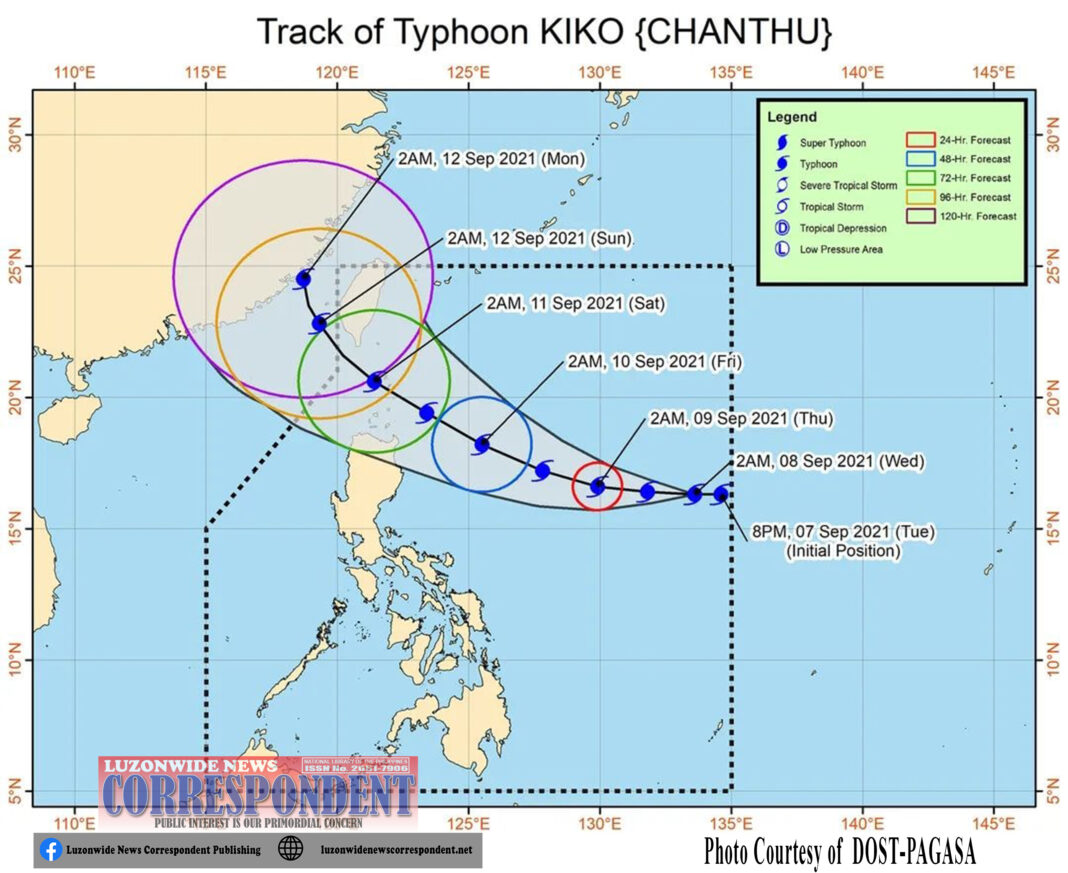Location of Center (4:00 AM)
The center of the eye of Typhoon “KIKO” was estimated based on all available data at 1,175 km East of Central Luzon (16.2°N, 133.1°E)
Intensity
Maximum sustained winds of 150 km/h near the center, gustiness of up to 185 km/h, and central pressure of 970 hPa
Present Movement
Westward at 20 km/h
Extent of Tropical Cyclone Winds
Strong winds or higher extend outwards up to 180 km from the center
TROPICAL CYCLONE WIND SIGNALS IN EFFECT
No Tropical Cyclone Wind Signal is currently in effect
HAZARDS AFFECTING LAND AREAS
Heavy Rainfall
• Heavy rains associated with the typhoon may begin affecting Extreme Northern Luzon on Friday. The public and disaster managers in these areas are advised to continue monitoring for updates and take appropriate preparatory activities.
Severe Winds
• Current track and intensity forecast shows that there is a moderate to high likelihood that Tropical Cyclone Wind Signals (TCWS) will be hoisted for several provinces in Northern Luzon, with higher wind signal levels possible over Extreme Northern Luzon. These wind signals may be hoisted for these localities beginning tonight or tomorrow morning. The highest possible wind signal that may be hoisted for this tropical cyclone is TCWS #4.
Coastal Inundation
• The public and disaster managers, especially those in localities of Extreme Northern Luzon are advised to monitor for updates in the coming days regarding the potential for coastal inundation due to the approaching typhoon.
HAZARDS AFFECTING COASTAL WATERS
In the next 24 hours, the typhoon is less likely to cause sea conditions over the coastal waters of the country which may pose threat to safety of lives at sea, especially for those using small sea vessels. However, mariners are advised to continue monitoring for updates as rough sea condition may begin affecting the northern and eastern seaboards of Luzon beginning tomorrow as the typhoon closes in on Extreme Northern Luzon. Due to the strength of this tropical cyclone, sea condition over the waters in the northern provinces of the country will likely be risky for all types of seacrafts in the coming days.
TRACK AND INTENSITY OUTLOOK
• On the forecast track, the typhoon is forecast to move westward or west northwestward until Friday towards Luzon Strait and the vicinity of Extreme Northern Luzon. Afterwards, the typhoon will turn northwestward and pass near the southern coast of Taiwan on Saturday before making landfall in the vicinity of southeastern China on Sunday evening or Monday morning.
• Due to favorable environmental conditions, the typhoon is expected to continuously intensify until Friday, when it is likely to reach its peak intensity of 185 to 205 km/h while moving over Extreme Northern Luzon. Weakening is possible on Saturday as it moves closer to Taiwan and interacts with its rugged terrain.
Considering these developments, the public and disaster risk reduction and management offices concerned are advised to take all necessary measures to protect life and property. Persons living in areas identified to be highly or very highly susceptible to these hazards are advised to follow evacuation and other instructions from local officials. For heavy rainfall warnings, thunderstorm/rainfall advisories, and other severe weather information specific to your area, please monitor products issued by your local PAGASA Regional Services Division.







